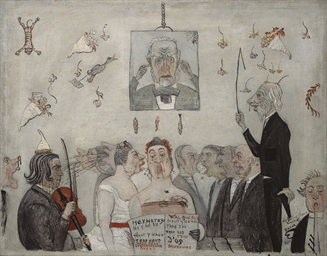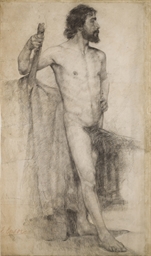James Ensor (1860-1949)
L'Entrée du Christ à Bruxelles (The Entry of Christ into Brussels) (D., Cr., T. 114; E. 118)
James Ensor (1860-1949) L'Entrée du Christ à Bruxelles (The Entry of Christ into Brussels) (D., Cr., T. 114; E. 118) drypoint and etching extensively hand-coloured with watercolour, 1898, on simili -Japan paper, Elesh's fourth, final state, signed and titled in pencil, with wide margins, pale light staining, occasional soft creasing in the margins, old brown paper tape along the sheet edges verso , otherwise in good condition Aside from personifications of Death, the figure of Christ takes an outstanding place within Ensor’s oeuvre. No fewer than thirteen of his etchings (see lots 56, 57, 59-73) depict scenes from the life of Christ. In an article for the anarchist magazine La Société Nouvelle, the eminent socialist intellectual César De Paepe had described Jesus as the first Jewish socialist. In the same spirit, Ensor in L’Entrée du Christ à Bruxelles imagined Jesus arriving as a revolutionary political figure during the maelstrom of the Brussels carnival. Ensor regularly attended carnivals in Ostend and Brussels and was fascinated by the energy and noise of the crowds, and their latent potential for violence. According to the gospels Jesus entered Jerusalem on Palm Sunday and was hailed as a liberating king. A few days later the same crowd shouted for his execution before the Roman authorities. The fickle nature of the throng is suggested by the many masked and grimacing faces, highly suggestive of Bosch and Breughel, evoking a terrible sense of foreboding. As the critic Arsène Alexandre wrote in his review for Le Figaro of Ensor’s exhibition at Salon des Cent in 1898-99, ‘James Ensor [is] a visionary, a Flemish artist in the purest tradition of old Hieronymus Bosch and Hell Brueghel. A surprising imagination, an evoker of crowds, a creator of fantastical sights, sometimes horrible, sometimes burlesque, most often both. [Quoted in: F. Dornhöffer, James Ensor in: Die Graphischen Künste, no. 23, Vienna, 1900, p. 35-42).
James Ensor (1860-1949)
L'Entrée du Christ à Bruxelles (The Entry of Christ into Brussels) (D., Cr., T. 114; E. 118)
James Ensor (1860-1949) L'Entrée du Christ à Bruxelles (The Entry of Christ into Brussels) (D., Cr., T. 114; E. 118) drypoint and etching extensively hand-coloured with watercolour, 1898, on simili -Japan paper, Elesh's fourth, final state, signed and titled in pencil, with wide margins, pale light staining, occasional soft creasing in the margins, old brown paper tape along the sheet edges verso , otherwise in good condition Aside from personifications of Death, the figure of Christ takes an outstanding place within Ensor’s oeuvre. No fewer than thirteen of his etchings (see lots 56, 57, 59-73) depict scenes from the life of Christ. In an article for the anarchist magazine La Société Nouvelle, the eminent socialist intellectual César De Paepe had described Jesus as the first Jewish socialist. In the same spirit, Ensor in L’Entrée du Christ à Bruxelles imagined Jesus arriving as a revolutionary political figure during the maelstrom of the Brussels carnival. Ensor regularly attended carnivals in Ostend and Brussels and was fascinated by the energy and noise of the crowds, and their latent potential for violence. According to the gospels Jesus entered Jerusalem on Palm Sunday and was hailed as a liberating king. A few days later the same crowd shouted for his execution before the Roman authorities. The fickle nature of the throng is suggested by the many masked and grimacing faces, highly suggestive of Bosch and Breughel, evoking a terrible sense of foreboding. As the critic Arsène Alexandre wrote in his review for Le Figaro of Ensor’s exhibition at Salon des Cent in 1898-99, ‘James Ensor [is] a visionary, a Flemish artist in the purest tradition of old Hieronymus Bosch and Hell Brueghel. A surprising imagination, an evoker of crowds, a creator of fantastical sights, sometimes horrible, sometimes burlesque, most often both. [Quoted in: F. Dornhöffer, James Ensor in: Die Graphischen Künste, no. 23, Vienna, 1900, p. 35-42).
.jpg)
.jpg)

.jpg)
.jpg)
.jpg)



.jpg)

.jpg)
.jpg)


Testen Sie LotSearch und seine Premium-Features 7 Tage - ohne Kosten!
Lassen Sie sich automatisch über neue Objekte in kommenden Auktionen benachrichtigen.
Suchauftrag anlegen